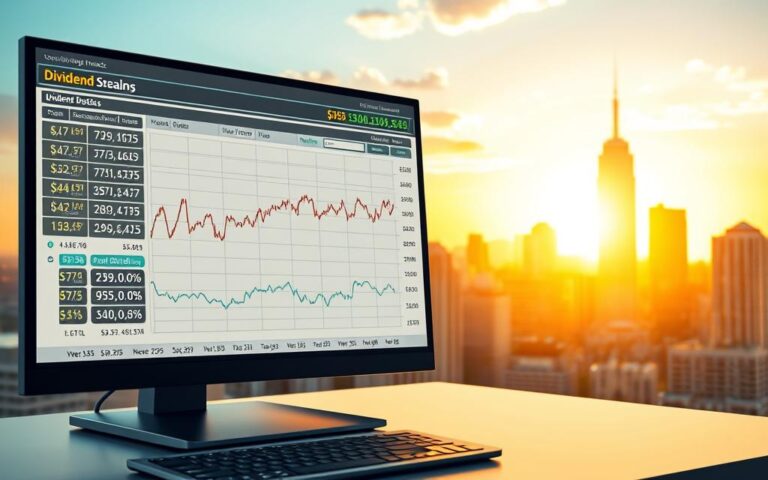Advertisement
Did you know reinvesting dividends can boost your investment returns significantly? Over 30 years, this can lead to more than a 20% increase. Understanding smart reinvestment is key for anyone wanting to grow their portfolio.
Reinvesting dividends helps compound your earnings and lets you buy more shares at no extra cost. By learning the investment strategies, you’ll see many benefits for your financial future. This guide will help you learn how to make smart reinvestment choices.
Understanding Dividend Reinvestment
Dividend reinvestment is a smart way for investors to grow their portfolios. Instead of taking cash, they use their dividends to buy more stocks. This increases their investment’s value over time, thanks to the magic of compounding. Knowing how this works helps investors plan their financial future better.
What is Dividend Reinvestment?
Dividend reinvestment means putting dividends back into more stock of the same company or another good choice. Instead of getting cash, investors buy more shares. This can make their future dividends even bigger. It’s a smart move to help your money grow over time.
Benefits of Reinvesting Dividends
The benefits of reinvesting dividends go beyond just getting more shares. Here are some key perks:
- It can significantly increase long-term growth because of compounding.
- Many DRIPs don’t charge fees for buying more shares.
- It helps you deal with market ups and downs better.
- It builds your share count, even when prices change.
How Dividend Reinvestment Plans Work
DRIPs automatically reinvest your dividends into additional shares. Often, these shares are priced lower than the market rate. DRIPs make reinvesting easy and you save on transaction costs. They’re a great way to keep adding to your investment without extra fees.

Choosing the Right Investment Strategy
It’s vital to know the difference between long-term and short-term investment strategies to reinvest dividends well. Each method has its own benefits and challenges. This is especially true when you align your investment plan with goals like value or growth investing. Knowing these strategies helps find the best way to reinvest dividends for growth.
Long-term vs Short-term Strategies
Long-term strategies mean keeping investments for years to let dividends build up and compound. This method is good for those into value investing. With patience and detailed analysis of underpriced stocks, big returns can happen over time. On the other hand, short-term strategies aim for quick gains which might lead to more trading and possibly lower dividends. Knowing your financial goals is key to picking the right strategy for reinvesting.
Value Investing with Reinvested Dividends
Value investing is about buying stocks that are priced low but pay consistent dividends. By reinvesting these dividends, investors can grow their stakes in solid companies. This approach not only looks for stock growth but also secures a steady income that increases over time. Smart use of dividends helps value investors expand their portfolios and grab market chances.
Growth Investing with Reinvested Dividends
Growth investing focuses on companies expected to grow a lot in the future, even if their current dividend yields are low. Reinvesting dividends in these promising stocks can speed up building wealth. This method suits those looking for long-term profits over quick income. It offers a chance to invest in companies with low dividends now but potential for big value increase later.

Assessing Your Financial Goals
Setting financial goals is key to creating effective investment plans. Investors need to pinpoint their aims to make smart choices. This helps them stay focused on long-term goals when choosing how to reinvest dividends.
Setting Clear Investment Objectives
Having clear financial goals is vital for success. Goals can be anything from saving for retirement, paying for a child’s college, or getting a house. A detailed plan helps direct investors to the right options to meet their goals over time.
Risk Tolerance and Reinvestment Choices
Knowing your risk tolerance is important for making investment decisions. It shows how much market change you can handle comfortably. People who don’t like risks might pick safer stocks. Those okay with risks might go for stocks with higher potential but more ups and downs. Understanding this helps pick a reinvestment plan suited to your financial situation.
Time Horizon for Investments
Your investment timeframe is crucial in setting goals. If you have a long way to go, you can usually handle more risks. This is because you have time to bounce back from market drops. But, if you need money sooner, you might want safer options for faster gains. Knowing your timeframe helps shape your investment strategy to fit your goals.
Selecting Qualified Dividend Stocks
Choosing the right dividend stocks needs careful thought. Investors must look at the current dividend pay and the company’s steadiness. It’s key to consider how often a company has paid dividends.
Factors to Consider in Stock Selection
There are several key points when picking dividend stocks:
- Company Stability: Go for stable companies as they’re less likely to cut dividends, offering a safer bet.
- Industry Trends: Knowing the company’s industry helps foresee if dividends can keep coming.
- Financial Health: Check the company’s debt and cash flow to see if it can keep paying dividends.
Importance of Dividend History
A company’s dividend history tells us about its dedication to its investors. Looking at past dividend actions shows us if a company is reliable. Strong dividend histories often point to a company’s pledge to keep investor value high, making these stocks good for reinvesting.
Evaluating Dividend Yield
Checking the dividend yield is crucial for understanding investment returns. A high yield sounds good but needs deep checking to avoid risks like dropping stock prices. It’s important to consider dividend yield with other factors for a complete view.
Utilizing Dividend Reinvestment Plans (DRIPs)
Dividend Reinvestment Plans, known as DRIPs, are a powerful way for investors to boost their investments. They let people automatically put their dividend payments back into more stock, making it easy to grow their portfolio. Realizing the value of DRIPs and learning to join can really improve your money management skills.
What Are DRIPs?
DRIPs allow you to reinvest your dividends into more company stock, often at a discount. This can make your investments grow over time. Many companies offer DRIPs directly, letting investors increase their shares without paying fees to brokers.
Advantages of Using DRIPs
DRIPs come with some great perks. Here are a few major ones:
- Commission-free purchases: You can get shares without paying extra fees, saving money.
- Substantial discounts: Some DRIPs let you buy stock below market price.
- Fractional shares: With DRIPs, you can buy parts of a share, using all of your dividend.
These benefits make DRIPs a smart choice for growing your wealth over time.
How to Enroll in a DRIP
Joining a DRIP is easy. Just follow these steps:
- Find companies with Dividend Reinvestment Plans. Look into the ones that interest you.
- See if you need to have shares in their account or through your broker.
- Fill out the enrollment form, found on the company’s website or through their services for shareholders.
- Turn in the form as they ask. You might need to provide more documents.
- Keep an eye on your account to make sure dividends are reinvested as you want.
Tax Implications on Reinvested Dividends
Understanding taxes on reinvested dividends is crucial for investors. Even though you reinvest them, these dividends are still taxed. This affects your total tax bill. Learning to report this income correctly is key.
Understanding Tax Responsibilities
Reinvested dividends face federal and possibly state taxes. This makes tax planning complex. Every dividend payment, reinvested or not, boosts your taxable income. Keeping good records is critical.
How Reinvested Dividends Are Taxed
Taxes are due on the cash value of reinvested dividends at your tax rate. For non-qualified dividends, this is usually the same as your income tax rate. It’s vital to know if your dividends are qualified or not. This helps get the best tax treatment.
Strategies to Minimize Taxes
Several strategies can help lower taxes on reinvested dividends. Using accounts like IRAs or 401(k)s is smart because they either grow tax-free or defer taxes. Choosing tax-efficient funds or picking growth stocks without dividends can also cut down taxes. Checking your tax situation yearly aids smart investing.
| Strategy | Description |
|---|---|
| Use of Tax-Advantaged Accounts | Investing within accounts like IRAs to defer taxes on dividends. |
| Invest in Growth Stocks | Focusing on stocks that reinvest earnings instead of paying dividends. |
| Tax-Loss Harvesting | Realizing losses to offset taxable gains from dividends. |
Diversification of Your Portfolio
Diversification is key in smart investing. It helps you balance your portfolio to lower risks during market ups and downs. When thinking about diversifying with dividend stocks, you need to look at several things that affect how much you might earn. Using a well-thought-out strategy makes your portfolio diverse. This approach leads to long-term growth and reduces the risk of losing money.
Importance of Diversifying Dividend Stocks
Putting all your money in one sector is risky. By picking dividend-paying stocks from many sectors, you make your investment strategy stronger. Diversifying with dividend stocks offers stability with regular payouts and the chance for growth. If one industry does badly, it doesn’t ruin your whole earnings thanks to investing in different industries.
Assessing Sector Exposure
Knowing how different sectors perform is essential for diversifying well. Each sector reacts differently to economic shifts. For example, consumer staples may do well when the economy struggles, while tech stocks might surge in a booming economy. By studying these trends, you can balance your investments to be less affected by sudden market changes.
Geographic Diversification
Spreading your investments across different countries adds to stability. This lets you take advantage of varying economic and market conditions worldwide. Regions vary in interest rates, rules, and consumer habits. Investing globally not only opens up more opportunities for making money but also protects against downturns in any one place.
| Sector | Example Stocks | Expected Growth Rate (%) | Dividend Yield (%) |
|---|---|---|---|
| Technology | Apple, Microsoft | 10 | 0.6 |
| Healthcare | Johnson & Johnson, Pfizer | 6 | 2.9 |
| Consumer Staples | Coca-Cola, Procter & Gamble | 5 | 3.2 |
| Financials | JPMorgan Chase, Bank of America | 7 | 2.5 |
Monitoring and Adjusting Your Investments
For successful investing, you need to keep an eye on your investments and update them based on ongoing evaluations. Regularly reviewing your portfolio helps ensure your investments match your financial goals. Knowing when to adjust your Dividend Reinvestment Plan (DRIP) is critical for your investment strategy.
Importance of Regular Portfolio Reviews
Reviewing your portfolio regularly ensures your investments align with your goals. This allows investors to check on performance, risk, and growth opportunities. By actively monitoring your investments, you can see when changes are needed. This leads to better results.
When to Reassess Your DRIP Strategy
Review your DRIP strategies from time to time, especially during market ups and downs or big changes in stock performance. Key times to rethink your DRIP include:
- Changes in the company’s dividend policy.
- Changes in your personal financial situation.
- Market shifts affecting stock values.
Indicators That It’s Time to Adjust Investments
There are signs that it’s time to tweak your portfolio. These signs include:
- Underperforming stocks: If certain stocks are not doing well consistently, you might need to think about their place in your portfolio.
- Market Trends: New trends or economic changes can impact your current investments.
- Risk Exposure: A portfolio that’s not balanced may carry too much risk; changing your investments can create a more secure situation.
The Role of Compounding in Reinvestment
Compounding is a powerful tool in finance. It can boost investment growth significantly. For those reinvesting dividends, knowing how compounding works is key to maximizing gains. We’ll look into compounding and its vital role in earning more over time.
What is Compounding?
Compounding increases an investment’s value since the investment’s earnings also earn interest. As dividends are put back into the investment, it grows bigger and faster. This shows how money can make more money. It’s a cycle that favors long-term investors.
How Compounding Affects Investment Growth
Compounding’s effect on investment growth is huge. When dividends are reinvested, they buy more shares. These extra shares then earn more dividends. Over years, this cycle greatly increases the value of the investment. The real power of compounding is seen when investors stick to their plan without cashing out early.
Examples of Compounding Returns
Let’s look at two investors, A and B, to see compounding in action:
| Investor | Initial Investment | Annual Return (%) | Years Invested | Final Value |
|---|---|---|---|---|
| Investor A | $1,000 | 5 | 10 | $1,628.89 |
| Investor B | $1,000 | 7 | 10 | $1,967.15 |
In this case, Investor A gets a 5% return annually, while Investor B enjoys a stronger 7% return. After ten years, Investor B ends up with significantly more money. This example clearly shows how a small difference in return can create a big impact over time.
Common Mistakes to Avoid
When reinvesting dividends, investors often make a few common errors. These mistakes can slow down their financial progress. Knowing what these errors are can help investors make smarter choices.
Overlooking Dividend Reliability
Many investors go after high dividend yields without thinking about dividend reliability. If a company’s dividends go up and down, it might mean trouble. It’s crucial to check if dividends are stable and consistent for lasting income.
Ignoring Market Conditions
Some investors ignore the overall market conditions. Yet, economic factors can deeply impact dividend payouts. Missing out on this increases the risk of losses. Keeping up with market trends and signs can reveal much about a company’s future dividends.
Focusing Solely on High Yields
Chasing after high yields can be a risky move. High yields might show that a company has big problems, like falling sales or bad management. Looking at both the yield and the company’s health can lead to smarter investments and more growth over time.
Resources for Smart Reinvestment
Starting your journey towards smart dividend reinvestment is exciting. Finding the right tools can make a big difference. Many investment platforms offer Dividend Reinvestment Plans (DRIPs). With DRIPs, you can automatically reinvest dividends into more shares. This method helps you use the power of compounding to your advantage. These platforms are easy to use and come with helpful guides to understand dividend investing better.
Investment Platforms with DRIP Options
Choosing a platform for DRIP is important. Look into TD Ameritrade, E*TRADE, and Charles Schwab for this. Not only do they offer DRIPs, but they also provide research tools and market insights. With these resources, you can pick high-quality dividend stocks and spread out your investments.
Financial Advisors and Investment Consultants
Talking to financial advisors can be very helpful. They offer advice that fits your investment goals and how much risk you’re willing to take. Advisors are great at explaining market trends and finding stocks that meet your needs. Their insights can really shape your dividend reinvestment plan.
Online Tools for Tracking Investments
Using online tools makes tracking your investments easy. Apps like Personal Capital and Mint show your dividend earnings and how they’re growing. This keeps you updated on how well your investments are doing. Adding these tools to your routine helps you make smarter decisions for your dividend reinvestment plan.



